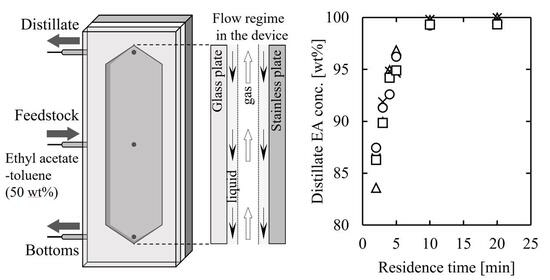Design Strategy for Performance Enhancement of Vertical Plate Microdistillators
Abstract
1. Introduction
2. Materials and Methods
2.1. Materials
2.2. Experimental Setup
2.3. Experimental Procedure
3. Results
3.1. Effect of Microdistillator Angle and Observation of Flow State in Microdistillator
3.2. Effect of Feedstock Composition and Heater Temperature
3.3. Effect of Microdistillator Channel Properties
3.4. Effect of Temperature Control at the Distillate Section
4. Discussion
5. Conclusions
Supplementary Materials
Author Contributions
Funding
Data Availability Statement
Conflicts of Interest
References
- McCreedy, T. Fabrication Techniques and Materials Commonly Used for the Production of Microreactors and Micro Total Analytical Systems. TrAC Trends Anal. Chem. 2000, 19, 396–401. [Google Scholar] [CrossRef]
- Mills, P.L.; Quiram, D.J.; Ryley, J.F. Microreactor Technology and Process Miniaturization for Catalytic Reactions—A Perspective on Recent Developments and Emerging Technologies. Chem. Eng. Sci. 2007, 62, 6992–7010. [Google Scholar] [CrossRef]
- Bojang, A.A.; Wu, H.-S. Design, Fundamental Principles of Fabrication and Applications of Microreactors. Processes 2020, 8, 891. [Google Scholar] [CrossRef]
- Maki, T.; Muranaka, Y.; Takeda, S.; Mae, K. Complex Polymer Nanoparticle Synthesis and Morphology Control Using an Inkjet Mixing System. Ind. Eng. Chem. Res. 2023, 62, 991–997. [Google Scholar] [CrossRef]
- Maki, T.; Takeda, S.; Muranaka, Y.; Mae, K. Silver Nanoparticle Synthesis Using an Inkjet Mixing System. Front. Chem. Eng. 2021, 3, 742322. [Google Scholar] [CrossRef]
- Watanabe, S.; Ohsaki, S.; Hanafusa, T.; Takada, K.; Tanaka, H.; Mae, K.; Miyahara, M.T. Synthesis of Zeolitic Imidazolate Framework-8 Particles of Controlled Sizes, Shapes, and Gate Adsorption Characteristics Using a Central Collision-Type Microreactor. Chem. Eng. J. 2017, 313, 724–733. [Google Scholar] [CrossRef]
- Irfan, M.; Shah, I.; Niazi, U.M.; Ali, M.; Ali, S.; Jalalah, M.S.; Khan, M.K.A.; Almawgani, A.H.M.; Rahman, S. Numerical analysis of non-aligned inputs M-type micromixers with different shaped obstacles for biomedical applications. Proc. Inst. Mech. Eng. Part E J. Process Mech. Eng. 2022, 236, 870–880. [Google Scholar] [CrossRef]
- Tamagawa, O.; Muto, A. Development of Cesium Ion Extraction Process Using a Slug Flow Microreactor. Chem. Eng. J. 2011, 167, 700–704. [Google Scholar] [CrossRef]
- Susanti, S.; Meinds, T.G.; Pinxterhuis, E.B.; Schuur, B.; de Vries, J.G.; Feringa, B.L.; Winkelman, J.G.M.; Yue, J.; Heeres, H.J. Proof of Concept for Continuous Enantioselective Liquid–Liquid Extraction in Capillary Microreactors Using 1-Octanol as a Sustainable Solvent. Green Chem. 2017, 19, 4334–4343. [Google Scholar] [CrossRef]
- Barkan-Öztürk, H.; Delorme, J.; Menner, A.; Bismarck, A. Liquid-Liquid Extraction Using Combined Hydrophilic-Hydrophobic Emulsion Templated Macroporous Polymer Micromixer-Settlers. Chem. Eng. Process.-Process Intensif. 2022, 181, 109153. [Google Scholar] [CrossRef]
- Timmer, B.H.; Van Delft, K.M.; Olthuis, W.; Bergveld, P.; Van Den Berg, A. Micro-Evaporation Electrolyte Concentrator. Sens. Actuators B Chem. 2003, 91, 342–346. [Google Scholar] [CrossRef]
- Hibara, A.; Toshin, K.; Tsukahara, T.; Mawatari, K.; Kitamori, T. Microfluidic Distillation Utilizing Micro–Nano Combined Structure. Chem. Lett. 2008, 37, 1064–1065. [Google Scholar] [CrossRef]
- Boyd, D.A.; Adleman, J.R.; Goodwin, D.G.; Psaltis, D. Chemical Separations by Bubble-Assisted Interphase Mass-Transfer. Anal. Chem. 2008, 80, 2452–2456. [Google Scholar] [CrossRef]
- Ziogas, A.; Cominos, V.; Kolb, G.; Kost, H.-J.; Werner, B.; Hessel, V. Development of a Microrectification Apparatus for Analytical and Preparative Applications. Chem. Eng. Technol. 2012, 35, 58–71. [Google Scholar] [CrossRef]
- Hartman, R.L.; Sahoo, H.R.; Yen, B.C.; Jensen, K.F. Distillation in Microchemical Systems Using Capillary Forces and Segmented Flow. Lab. Chip 2009, 9, 1843. [Google Scholar] [CrossRef]
- Wootton, R.C.R.; deMello, A.J. Continuous Laminar Evaporation: Micron-Scale Distillation. Chem. Commun. 2004, 266–267. [Google Scholar] [CrossRef]
- Sundberg, A.; Uusi-Kyyny, P.; Alopaeus, V. Novel Micro-Distillation Column for Process Development. Chem. Eng. Res. Des. 2009, 87, 705–710. [Google Scholar] [CrossRef]
- Sundberg, A.T.; Uusi-Kyyny, P.; Jakobsson, K.; Alopaeus, V. Control of Reflux and Reboil Flow Rates for Milli and Micro Distillation. Chem. Eng. Res. Des. 2013, 91, 753–760. [Google Scholar] [CrossRef]
- Seok, D.R.; Hwang, S.-T. Zero-Gravity Distillation Utilizing the Heat Pipe Principle(Micro-Distillation). AIChE J. 1985, 31, 2059–2065. [Google Scholar] [CrossRef]
- Lam, K.F.; Cao, E.; Sorensen, E.; Gavriilidis, A. Development of Multistage Distillation in a Microfluidic Chip. Lab. Chip 2011, 11, 1311. [Google Scholar] [CrossRef]
- Lam, K.F.; Sorensen, E.; Gavriilidis, A. Towards an Understanding of the Effects of Operating Conditions on Separation by Microfluidic Distillation. Chem. Eng. Sci. 2011, 66, 2098–2106. [Google Scholar] [CrossRef]
- Zhang, Y.; Kato, S.; Anazawa, T. Vacuum Membrane Distillation by Microchip with Temperature Gradient. Lab. Chip 2010, 10, 899. [Google Scholar] [CrossRef] [PubMed]
- MacInnes, J.M.; Ortiz-Osorio, J.; Jordan, P.J.; Priestman, G.H.; Allen, R.W.K. Experimental Demonstration of Rotating Spiral Microchannel Distillation. Chem. Eng. J. 2010, 159, 159–169. [Google Scholar] [CrossRef]
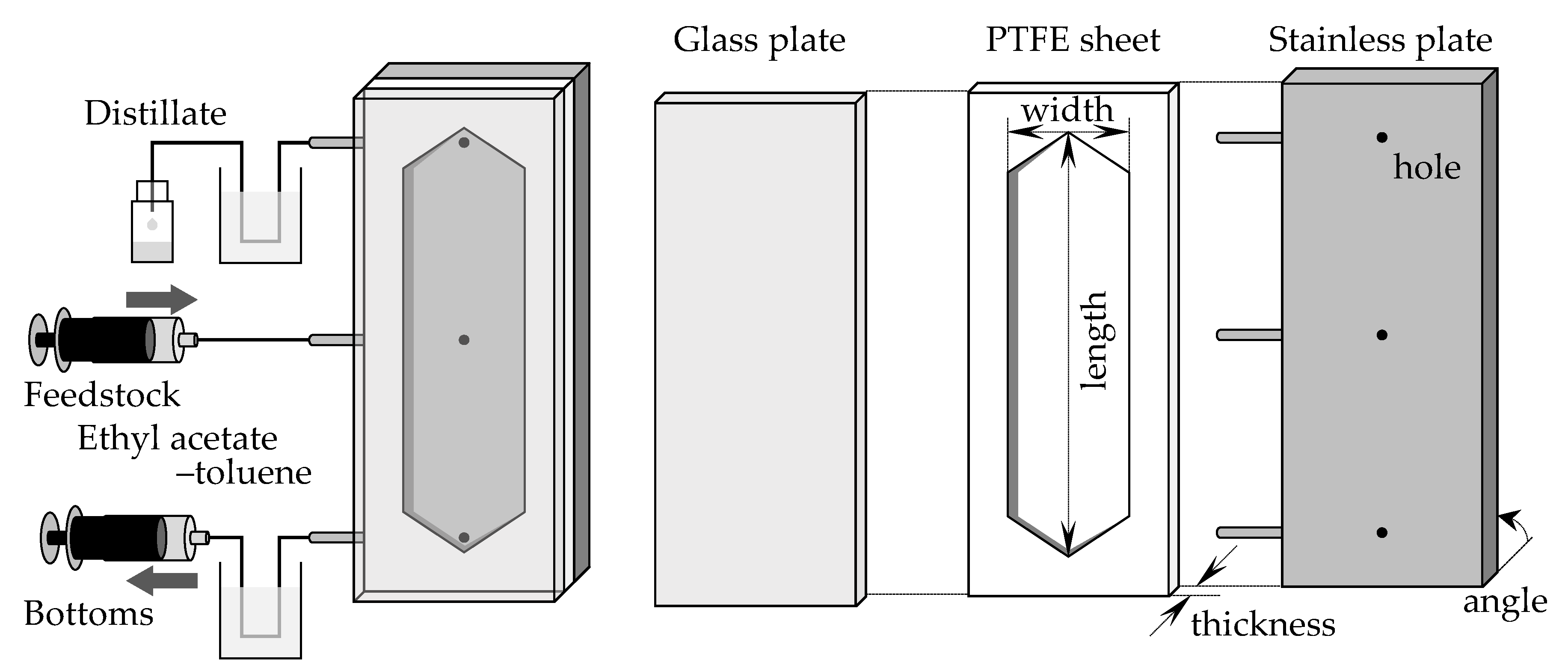

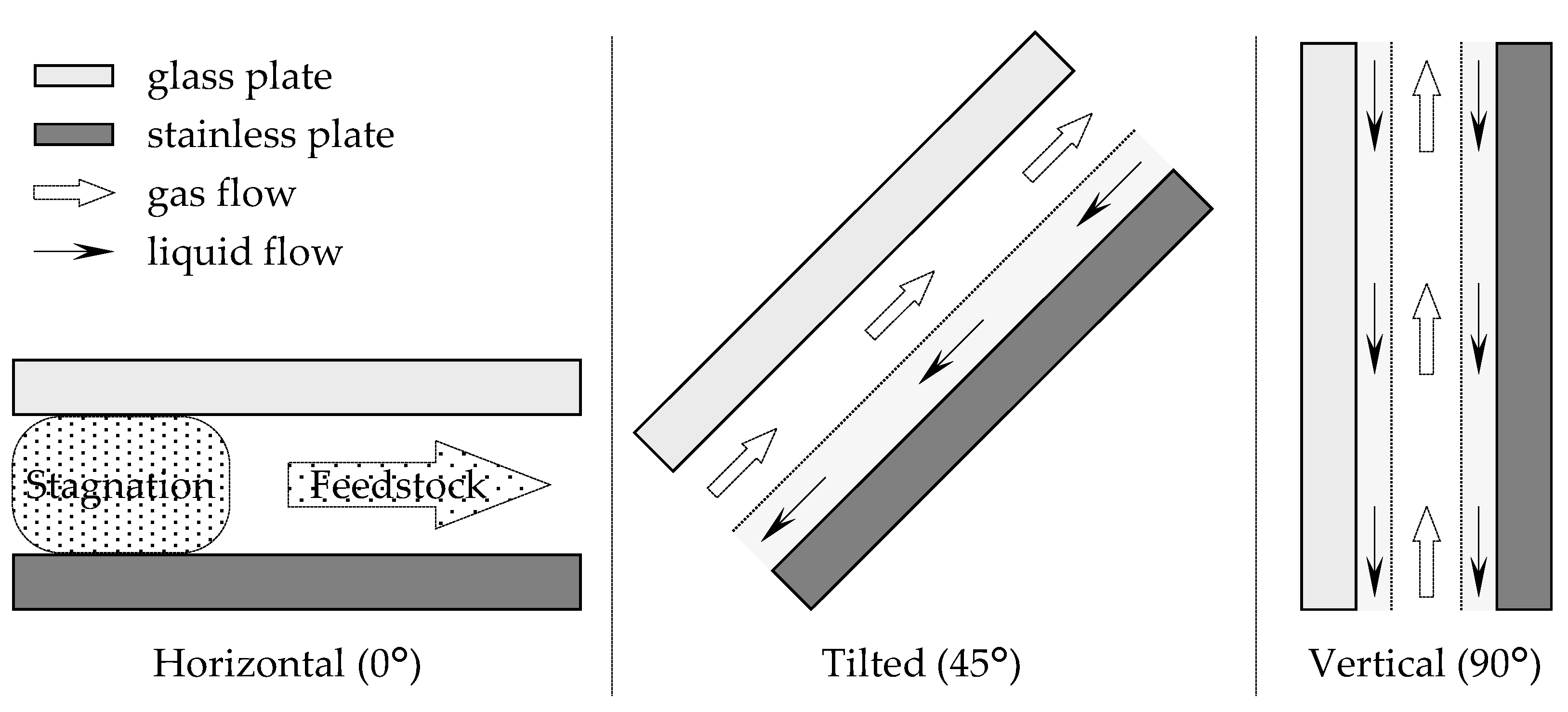
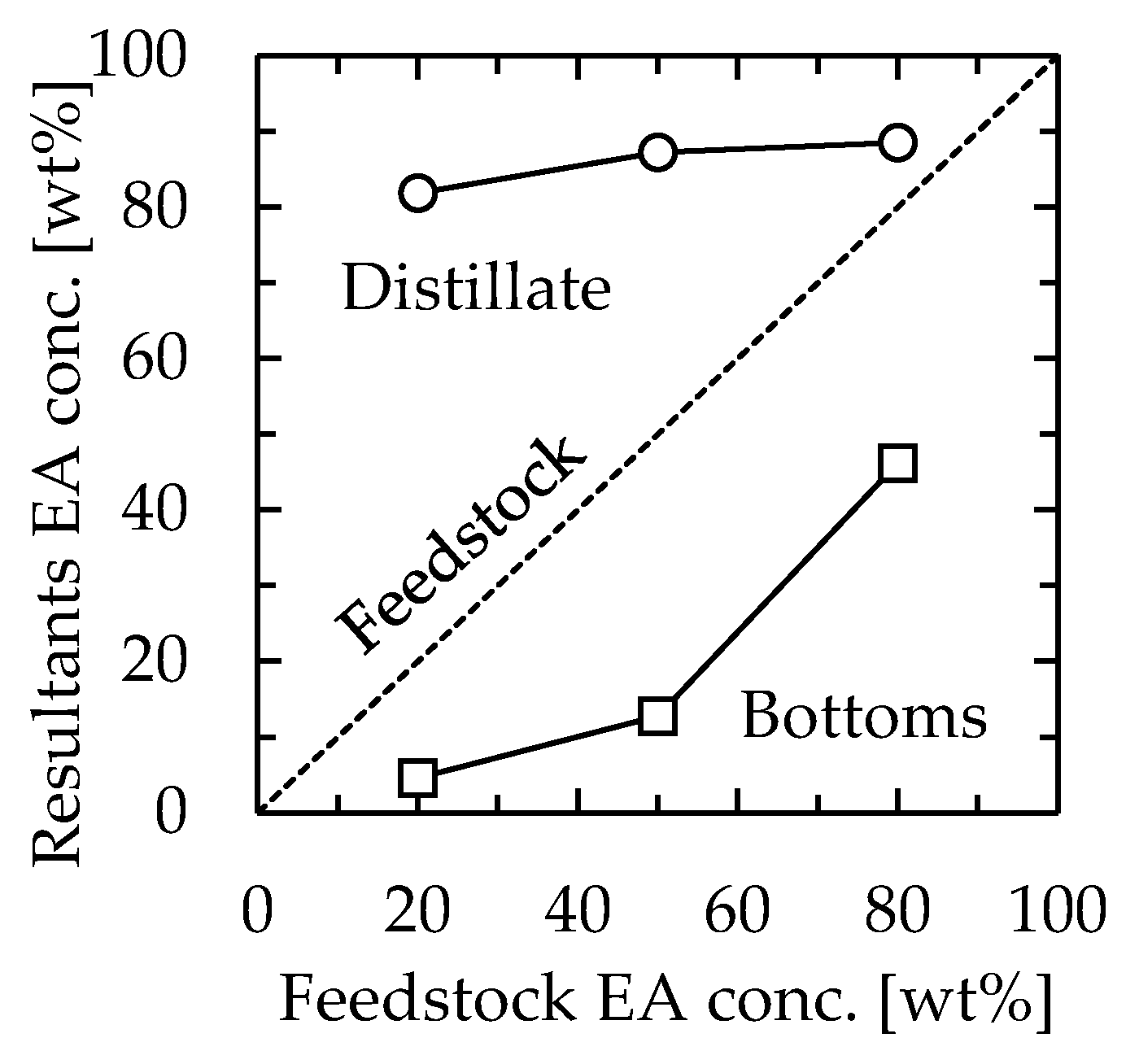
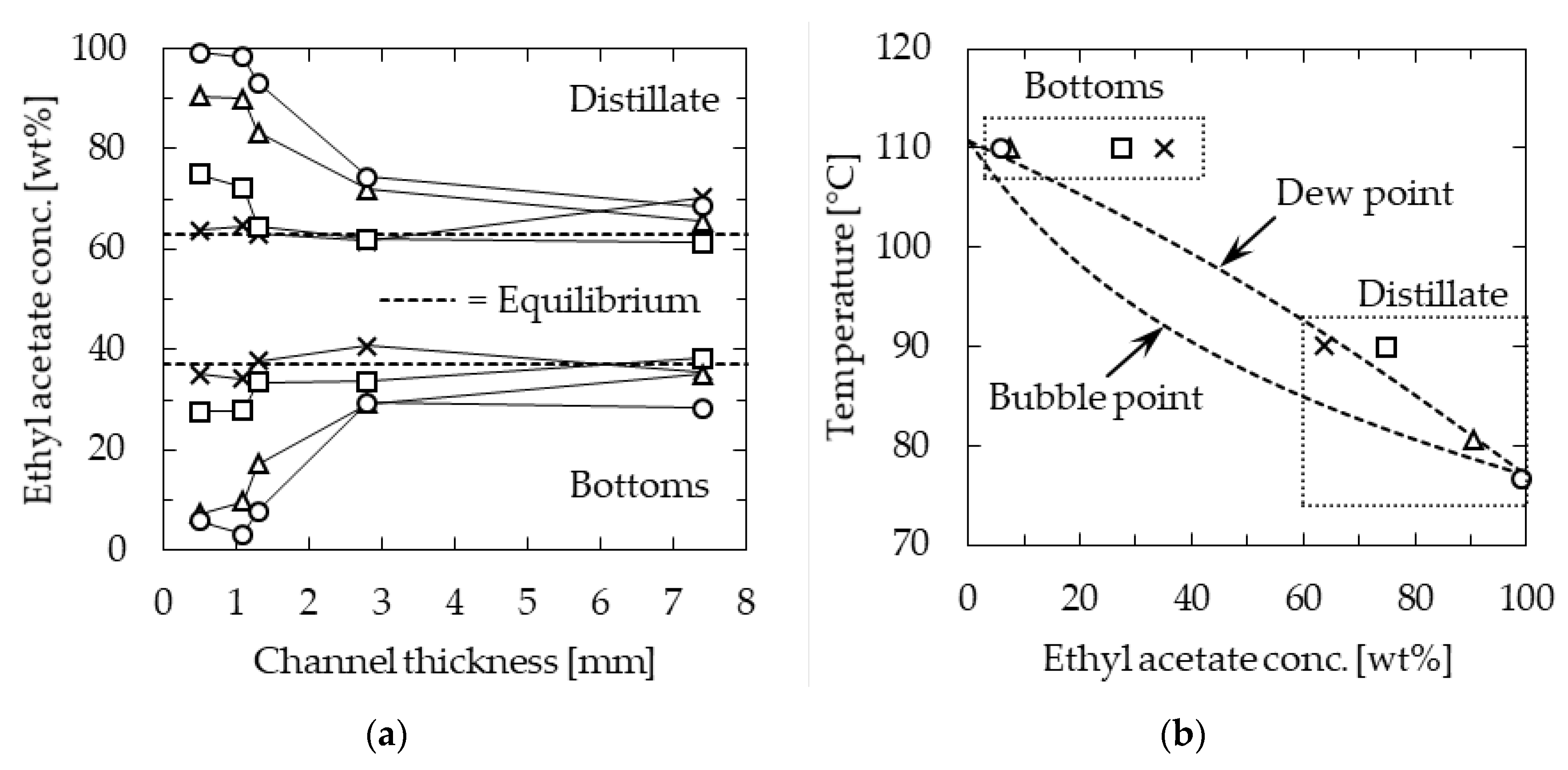
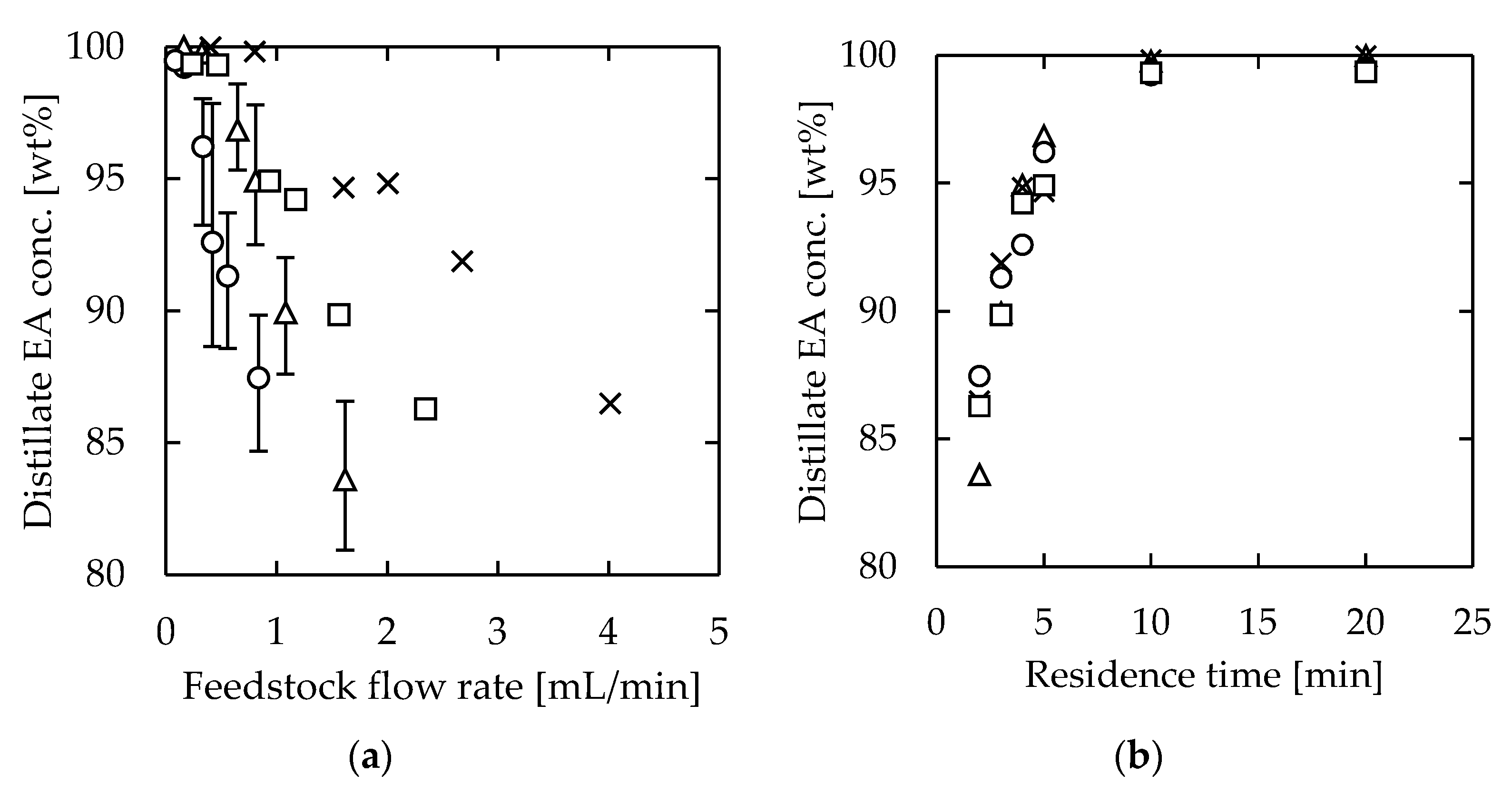
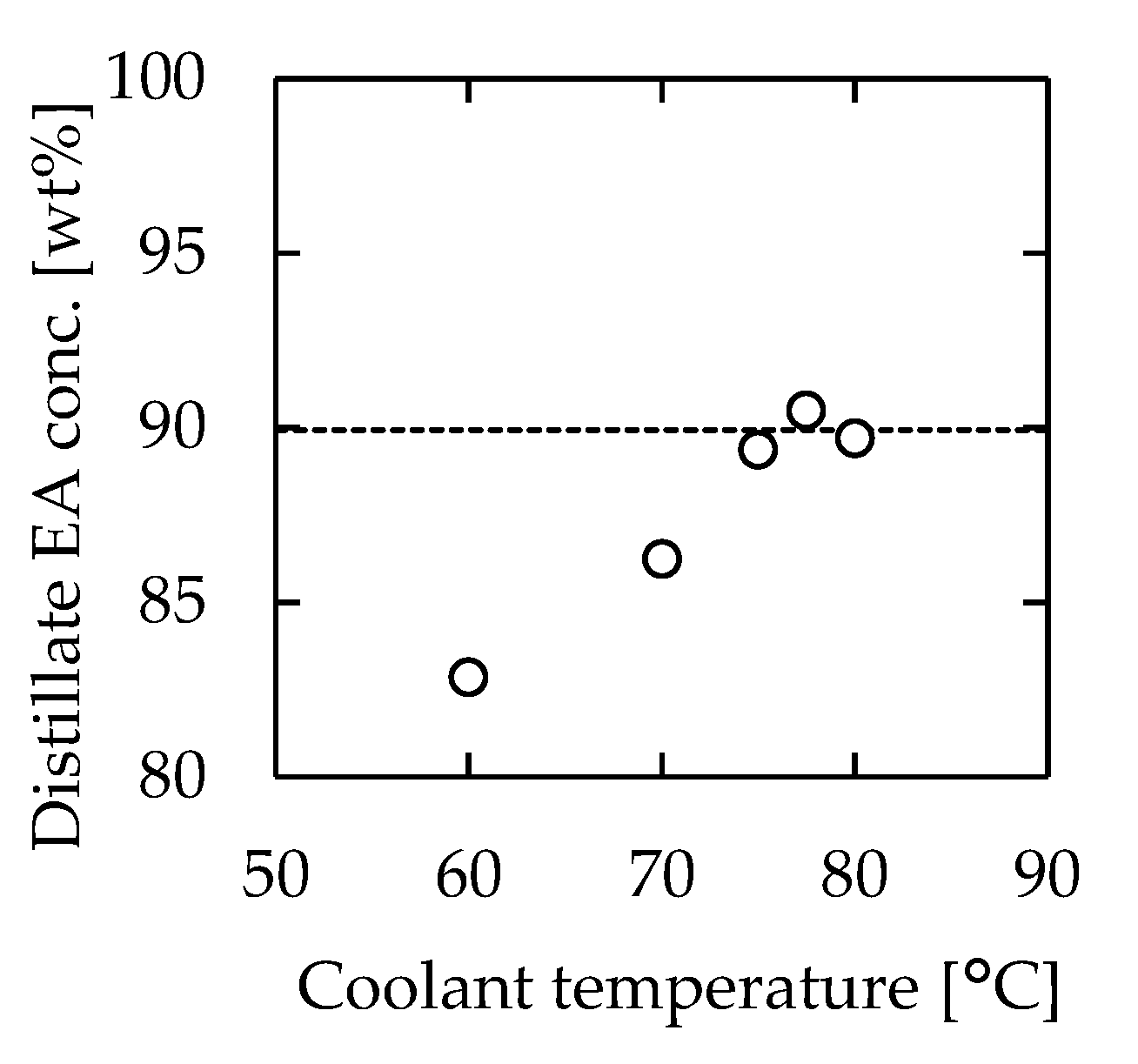
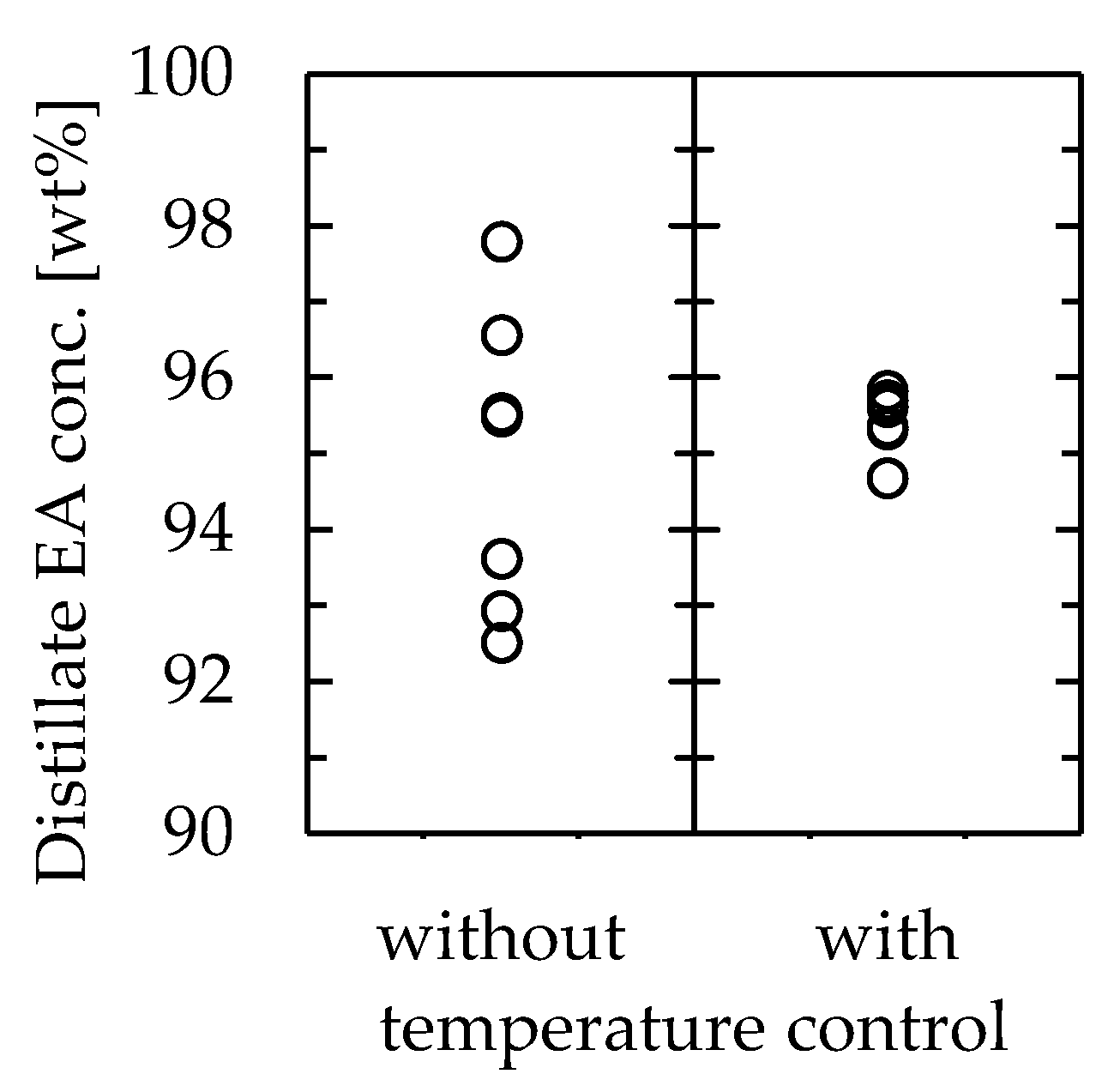
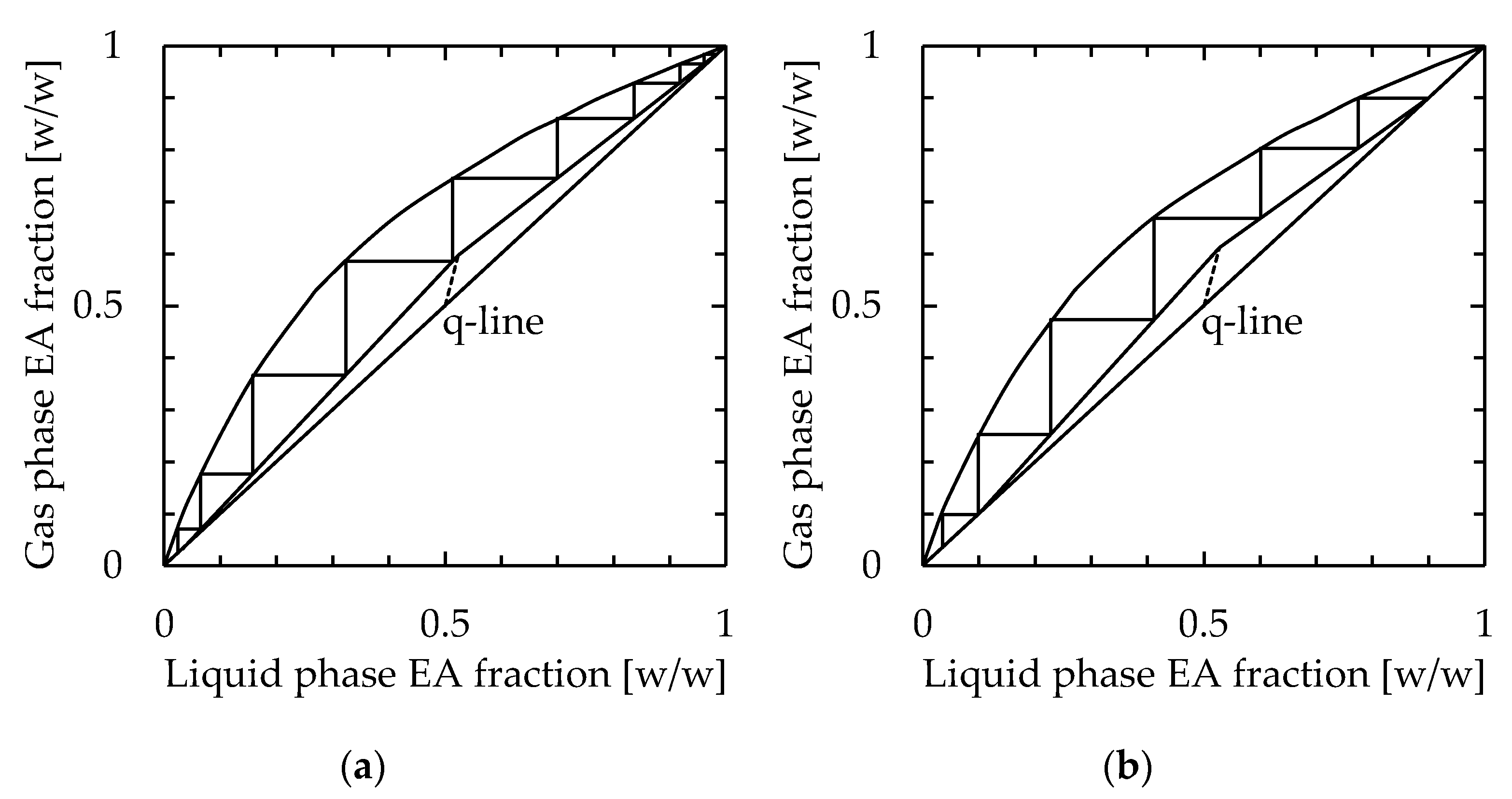
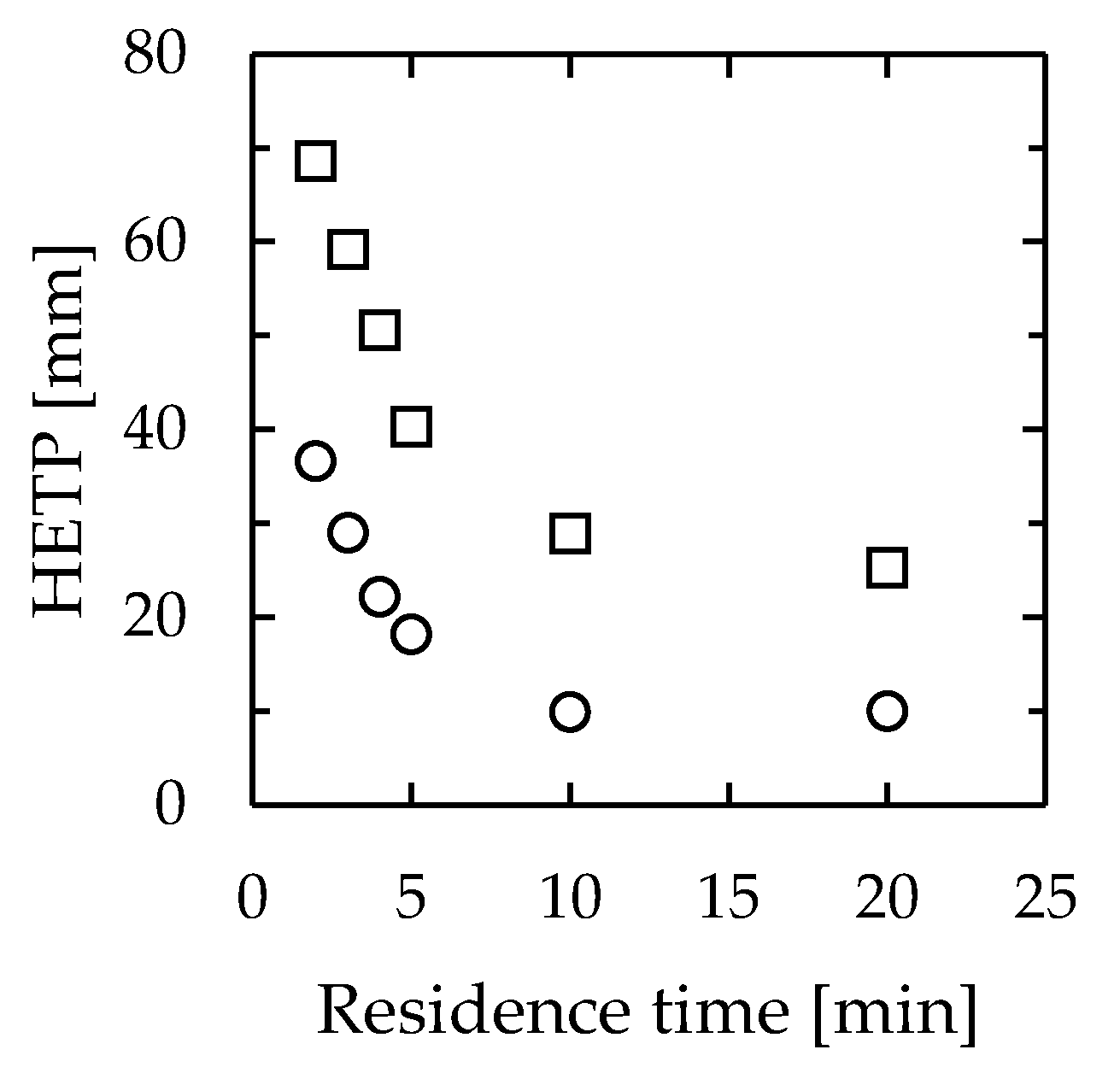
| Length | Width | Thickness | Volume | Surface Area | Specific Surface Area |
|---|---|---|---|---|---|
| [mm] | [mm] | [mm] | [cm3] | [cm2] | [cm−1] |
| 115 | 30 | 0.5 | 1.6 | 65.8 | 40.8 |
| 115 | 30 | 1.1 | 3.5 | 67.4 | 19.0 |
| 115 | 30 | 1.3 | 4.2 | 68.0 | 16.2 |
| 115 | 30 | 2.8 | 9.0 | 72.0 | 8.0 |
| 115 | 30 | 7.4 | 23.9 | 84.2 | 3.5 |
| 115 | 15 | 1.0 | 1.6 | 34.9 | 21.7 |
| 115 | 30 | 1.0 | 3.2 | 67.2 | 20.8 |
| 275 | 15 | 1.0 | 4.0 | 86.1 | 21.5 |
| 275 | 30 | 1.0 | 8.0 | 166.4 | 20.7 |
Disclaimer/Publisher’s Note: The statements, opinions and data contained in all publications are solely those of the individual author(s) and contributor(s) and not of MDPI and/or the editor(s). MDPI and/or the editor(s) disclaim responsibility for any injury to people or property resulting from any ideas, methods, instructions or products referred to in the content. |
© 2023 by the authors. Licensee MDPI, Basel, Switzerland. This article is an open access article distributed under the terms and conditions of the Creative Commons Attribution (CC BY) license (https://creativecommons.org/licenses/by/4.0/).
Share and Cite
Muranaka, Y.; Maki, T.; Nishigaya, K.; Mae, K. Design Strategy for Performance Enhancement of Vertical Plate Microdistillators. Separations 2023, 10, 404. https://doi.org/10.3390/separations10070404
Muranaka Y, Maki T, Nishigaya K, Mae K. Design Strategy for Performance Enhancement of Vertical Plate Microdistillators. Separations. 2023; 10(7):404. https://doi.org/10.3390/separations10070404
Chicago/Turabian StyleMuranaka, Yosuke, Taisuke Maki, Kosuke Nishigaya, and Kazuhiro Mae. 2023. "Design Strategy for Performance Enhancement of Vertical Plate Microdistillators" Separations 10, no. 7: 404. https://doi.org/10.3390/separations10070404
APA StyleMuranaka, Y., Maki, T., Nishigaya, K., & Mae, K. (2023). Design Strategy for Performance Enhancement of Vertical Plate Microdistillators. Separations, 10(7), 404. https://doi.org/10.3390/separations10070404








